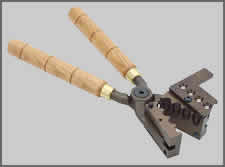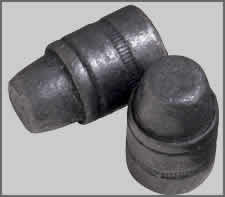Home | Glossary | Resources | Help | Contact Us | Course Map
Archival Notice
This is an archive page that is no longer being updated. It may contain outdated information and links may no longer function as originally intended.
Casting
Surviving to modern times, the all-lead bullet is the oldest type of cartridge projectile. Lead is a soft metal, easily worked by mechanical shaping or casting in molds. With simple equipment, it is readily alloyed with other low-melting-point metals (such as tin and antimony) to produce a harder final product.
Generally, lead projectiles are used for low-pressure and low-velocity cartridges, such as .22 caliber rimfire cartridges. Shotshells use lead pellets, although lead-free pellets are now required for waterfowl shooting.
Casting bullets is the oldest manufacturing method, but it has limitations. Pouring molten lead into a mold to make quality bullets requires careful attention. Without monitoring lead temperature, mold temperature, pouring rates, alloy consistency, and cooling rates, the resulting bullets will not have the uniformity required by modern standards.
Casting has advantages, such as the ability to produce sharp edges and detailed surface features. Lead alloys that are too hard for cold forming may be cast. As factories became more reliant on power equipment, cold forming (or swaging) was widely adopted to speed production. Hard alloys were not required for the firearms of the day. Secondary operations (required when swaging failed to produce some bullet features like grooves that would have been cast) had to be developed.
Swaging
Swaging requires a punch and die set mounted in a press, providing a mechanical advantage. The die cavity is shaped to match the desired profile of the bullet. The lead feeding into the swage die is normally a rough cylinder or slug that is somewhat smaller than the finished diameter of the bullet. Excess lead bleeds off as sprue.
The slug is cut from a long wire of lead that has been extruded under great pressure. A large billet of lead (usually cast) is placed in a massive hydraulic press and forced through a small hole in a die to form lead wire.
A post-swaging operation may add cannelures (or grooves) to hold extra lubricant and/or to provide a recess for securing the bullet in the cartridge case by crimping.
After the cannelure operation, bullets are sent to the lubrication area, where synthetic lubricants are applied. In some bullets, the lubricant is applied only in the cannelure, requiring special equipment and slowing the production rate. Most mass-produced bullets are dipped, covering the entire surface with lubricant.
Shot Pellets
Small shot pellets, generally classified as birdshot, were formed by the action of gravity on molten lead. The lead used in pellets was usually hardened with traces of antimony or arsenic to reduce deformation.
Small lead pellets (drop shot) were traditionally produced in a structure called a shot tower that may have measured up to ten stories tall.
The steps in this obsolete method were as follows:
- A quantity of lead was melted in a large vat at the top of the tower.
- The lead flowed into a broad shallow pan with fine holes in the bottom.
- A device struck this pan several times a second.
- Molten lead flowed as streams from holes in the stationary pan; vibration from the impact broke the streams into droplets of random size.
- During the long fall, surface tension and gravity caused the drops to become rounded.
- A tank of water at the bottom of the tower cushioned the fall, collected the pellets, and completed the cooling.
- Pellets were separated by shape (spheres produced the best shotgun patterns).
- Rejected pellets were recycled for remelting.
A GNU head Permission is granted to copy, distribute and/or modify this document under the terms of the GNU Free Documentation License, Version 1.2 or any later version published by the Free Software Foundation; with no Invariant Sections, no Front-Cover Texts, and no Back-Cover Texts.
Additional Online Courses
- What Every First Responding Officer Should Know About DNA Evidence
- Collecting DNA Evidence at Property Crime Scenes
- DNA – A Prosecutor’s Practice Notebook
- Crime Scene and DNA Basics
- Laboratory Safety Programs
- DNA Amplification
- Population Genetics and Statistics
- Non-STR DNA Markers: SNPs, Y-STRs, LCN and mtDNA
- Firearms Examiner Training
- Forensic DNA Education for Law Enforcement Decisionmakers
- What Every Investigator and Evidence Technician Should Know About DNA Evidence
- Principles of Forensic DNA for Officers of the Court
- Law 101: Legal Guide for the Forensic Expert
- Laboratory Orientation and Testing of Body Fluids and Tissues
- DNA Extraction and Quantitation
- STR Data Analysis and Interpretation
- Communication Skills, Report Writing, and Courtroom Testimony
- Español for Law Enforcement
- Amplified DNA Product Separation for Forensic Analysts




